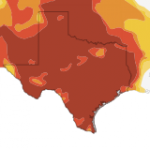Life By the Drop: Where Drought Meets the Sea, A Q&A With Leslie Hartman

Photo by Filipa Rodrigues for StateImpact Texas.
Leslie Hartman is the Matagorda Bay Ecosystem Leader for the Texas Parks and Wildlife Department.
Drought looks different along the Texas coast. When you hear the cries of seagulls and the roll of the surf you might be forgiven for thinking that nothing is wrong at all. But as last year’s drought pushed through the summer, the Colorado River brought less and less fresh water into the Gulf of Mexico and the state bay systems suffered. In Matagorda Bay, where the river empties into the sea oyster harvesting was shut down and fishermen reported fewer crabs and fish.
As part of StateImpact Texas’ reporting for Life By the Drop: Drought, Water and the Future of Texas, StateImpact’s Mose Buchele sat down with Leslie Hartman, the Matagorda Bay Ecosystem Leader for Texas Parks and Wildlife Department to talk drought and water issues along the coast.
Q: How important is the Colorado to the Matagorda Bay ecosystem?
A: Freshwater is essential. You don’t have a bay ecosystem without having your fresh water meet your saltwater, that’s actually part of the definition of an estuary. And bays are usually estuaries, it’s all one.
Q: So what impact does that have?
A: Well, coastal places are very productive. Where you have your fresh water and your salt water meet, you have a lot of nutrient loading. And what you have there, is this is a nursery area.
Every bay, every estuary serves as a nursery. So you have your baby shrimp, your baby crabs, your young fish, all growing up here in the bay. And without having that nutrient loading coming from fresh water, without some of the other processes that are involved, you’re not going to have as numerous a population of fish and shrimp and crabs as you might.
Q:And then that begins to impact the entire gulf ecosystem?
A: Definitely greater impact, the last number I saw says that 98 percent of the species that live in the world’s ocean start part of their life-cycle in the bay. Might not be our bay, but it’s somebody’s bay. And that’s how important bays are to the global ocean.
Q: So what did you see happening last year with the drought?
A: You definitely saw the salinities were really high, they were actually oceanic levels of salinity last year. And actually in east Matagorda Bay, which is a much shallower body of water, the evaporation rates were so high last year that we actually went what we call “Hyper saline” or above oceanic salinities. And not all fish are comfortable when there’s that much salt in the water.
Q: I hear a lot about fertilizer coming down in Mississippi, what impact can that have on the Gulf?
A: You know we all use fertilizer for our yards, and it just causes things to grow a lot. Algae are a vegetables basically. Algae, if it starts to overgrow and is not controlled by grazers, you can  suddenly have what we call a bloom. And if you get this bloom, it produces a lot of oxygen during the day when the sun is out, but at night, it actually uses oxygen and basically it’ll suck the oxygen out of the water, and fish need oxygen.
suddenly have what we call a bloom. And if you get this bloom, it produces a lot of oxygen during the day when the sun is out, but at night, it actually uses oxygen and basically it’ll suck the oxygen out of the water, and fish need oxygen.
If the algae are there, and there’s no oxygen there, the fish will either move out, or they’ll start to die. And it gets into a vicious cycle whereas fish start to die, they start to decompose which adds to the whole taking out the oxygen from the water.
Q: What are the concerns about development? Either upstream or right here?
A: I want you to imagine an English muffin. It has a lot of nooks and crannies in it. If I am a very young larval shrimp or crab, I can come up there, and in the sides of an English muffin, which is what our marsh edges usually look like. You can have hundreds if not thousands of larval shrimp and crab living in there, it’s like a metropolitan complex.
Sometimes in development, we want to put these straight bulkheads in, which are there to protect property, and you’re putting a flat surface where an english muffin used to be. It’s not a direct exchange, and so you can see that’s going to sustain fewer shrimp and crab and whatnot. Humans have a right to be here, but we’ve got to be here smart.

